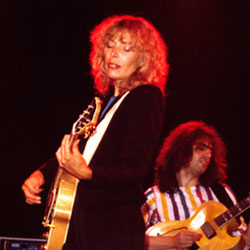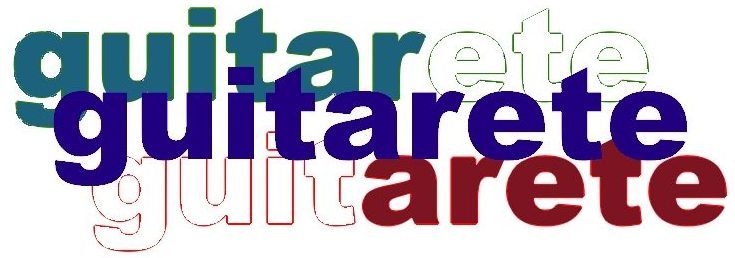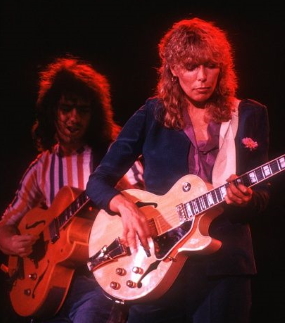Pat Metheny’s presence in Joni Mitchell’s touring band is one among his rare appearances as a sideman to an artist from outside the jazz world. Well before his 1979 gig as Mitchell’s lead guitarist, Pat Metheny had in place a sound and style very much his own. Throughout much of the show, he presses his well-known tone—via a Gibson ES-175 into a pair of clean Acoustic combos, gently enhanced with asymmetrical delay settings—into the service of songs distant from his own.
Part 2 of 2—Pat Metheny
Be sure to read Part 1, which focuses on Joni Mitchell’s song “Furry Sings the Blues” and her distinctive use of alternate tunings.
While Mitchell fingerpicks her Ibanez hollowbody, Metheny hangs back and creates depth. Combining a glass slide with volume-pedal swells, Metheny negates nearly all the front end of his long tones. A generous amount of delay adds air and allows notes to swoop and expand. Best of all is Metheny’s sensitivity to Mitchell’s singing. At one moment, he underlines one of the singer’s silky crescendoing tones with an echoey chord, blurred by light tremolo picking and slide vibrato. At another, he fills a space in the melody with a couple of well-placed delayed fourths. Metheny’s ambient engagement deepens Mitchell’s unflinching and self-aware portrayal of Walter “Furry” Lewis’s conflicted reckoning with the decline of his health, the decay of his scene, and the seemingly puzzling presence of someone such as herself.

In a recent interview to which Mitchell’s web site links, Metheny spoke of his time in Mitchell’s band and his appreciation of her artistry. Here is his exchange with interviewer Warren Linhart:
W.L.: In the news recently, there have been stories about the upcoming Woodstock anniversary and also some about Joni Mitchell turning 75 [Mitchell wrote the song “Woodstock” which was made famous by Crosby, Stills, Nash and Young.] You were part of the terrific band that was on the tour to support her album “Mingus” back in the 70s. (Mitchell’s album “Shadows and Light” was subsequently released with performances culled from that tour.) Thinking back now, what was that opportunity like for you and what did you come away with from that experience?
P.M.: She’s great. If think about the musicians that I’ve been around that really impacted me, if I think about the gigs that I played that have been unbelievable, they’ve mostly been with people who are fluent in the broadest sense of what music is, there’s a kind of a sense of infinity when you’re on the bandstand with people like Herbie Hancock, Elvin Jones, Roy Haynes, or Ornette (Coleman) — you’re dealing with infinity. For me, that requires a broad knowledge of music. There are lots of musicians who are dealing with a not broad realm of music but one where that realm goes very deep. Joni didn’t really have a whole range of things, it was like a sliver; BUT, it was way, way, way deep and that is just as valuable and important as anything else. The main thing I carried from that experience is the admiration for how great she is and was.
It’s clear that Metheny regards Mitchell’s talent of a different nature than that of the jazz aristocracy with whom he has played and among whom he is often now counted. When he speaks of the “sense of infinity” he encounters onstage with those who calls “fluent in the broadest sense of what music is,” he seems, based on the players he references, to be referring to improvisational virtuosity. His appreciation, however, extends to artists such as Mitchell, with whom, one can infer, he is aware one plays differently than with virtuous improvisers. Whether or not Joni Mitchell was “dealing with a not broad realm of music” in comparison with the others Metheny mention can certainly be a matter of controversy. I’m pretty sure that the distinction among musicians that Metheny made in this interview would benefit from more discussion. Wherever such a discussion may lead, what is much clearer is that the interaction between Mitchell and Metheny on the Shadows and Light version of “Furry Sings the Blues” lent a lonelier, bluer new shade to the song beyond its original presentation. They are not singing and playing the blues. They are singing and playing from outside the idiom about someone who sang and played the blues and also about someone else in the orbit of the bluesman–a complex dual-perspective that I think is enhanced by Metheny’s choice to subvert the characteristically bold, bluesy sound of slide guitar into a lonely surround for the song’s disconnected characters.
(Be sure to read Part 1, which focuses on Joni Mitchell’s song “Furry Sings the Blues” and her distinctive use of alternate tunings.)
Click the link below to buy Shadows and Light (and to support Guitarete)!
©2019 Guitarete/Alan Barry

